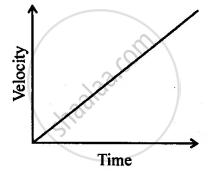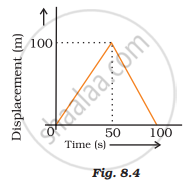Advertisements
Advertisements
Question
A bus running at a speed of 18 km/h is stopped in 2.5 seconds by applying brakes. Calculate the retardation produced.
Solution
We have to find the value of retardation. So,
Initial velocity,
`(u)` = 18 km/hr
= `"18(1000)"/3600` m/s
= 5 m/s
Final velocity, (v) = 0 m/s
Acceleration , `a = (v-u)/t`
Put the values in the above equation to get the value of acceleration
`a = (0-5)/2.5`
= `-2 "m/s"^2`
Thus, the retardation is 2 m/s2.
APPEARS IN
RELATED QUESTIONS
A bus decreases its speed from 80 km h−1 to 60 km h−1 in 5 s. Find the acceleration of the bus.
Which of the two can be zero under certain conditions : average speed of a moving body or average velocity of a moving body ?
Describe the motion of a body which is accelerating at a constant rate of 10 m s–2. If the body starts from rest, how much distance will it cover in 2 s ?
A car is travelling along the road at 8 ms-1. It accelerates at 1 ms-2 for a distance of 18 m. How fast is it then travelling ?
If a stone and a pencil are dropped simultaneously in vacuum from the top of a tower, then which of the two will reach the ground first? Give reason.
The figure shows the displacement - time graph for four bodies A, B C and D. In each case state what information do you get about the acceleration (zero, positive or negative).

Multiple choice Question. Select the correct option.
At the maximum height, a body thrown vertically upwards has :
Can you suggest a real-life example about the motion of a body from the following velocity – time graph?

Area under a v – t graph represents a physical quantity which has the unit
A girl walks along a straight path to drop a letter in the letterbox and comes back to her initial position. Her displacement–time graph is shown in Fig.8.4. Plot a velocity-time graph for the same.

